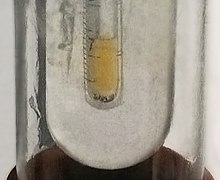Fluorine
Fluorine (symbol F) is a chemical element that is very poisonous. Its atomic number (which is the number of protons in it) is 9, and its atomic mass is 19. It is part of the Group 7 (halogens) on the periodic table of elements.
 Liquid fluorine (at extremely low temperatures) | |||||||||||||||||||||
| Fluorine | |||||||||||||||||||||
|---|---|---|---|---|---|---|---|---|---|---|---|---|---|---|---|---|---|---|---|---|---|
| Pronunciation | |||||||||||||||||||||
| Allotropes | alpha, beta (see Allotropes of fluorine) | ||||||||||||||||||||
| Appearance | gas: very pale yellow liquid: bright yellow solid: alpha is opaque, beta is transparent | ||||||||||||||||||||
| Standard atomic weight Ar°(F) | |||||||||||||||||||||
| 18.998403163(6)[1] | |||||||||||||||||||||
| Fluorine in the periodic table | |||||||||||||||||||||
| |||||||||||||||||||||
| Group | group 17 (halogens) | ||||||||||||||||||||
| Period | period 2 | ||||||||||||||||||||
| Block | p-block | ||||||||||||||||||||
| Electron configuration | [He] 2s2 2p5[2] | ||||||||||||||||||||
| Electrons per shell | 2, 7 | ||||||||||||||||||||
| Physical properties | |||||||||||||||||||||
| Phase at STP | gas | ||||||||||||||||||||
| Melting point | 53.48 K (−219.67 °C, −363.41 °F)[3] | ||||||||||||||||||||
| Boiling point | 85.03 K (−188.11 °C, −306.60 °F)[3] | ||||||||||||||||||||
| Density (at STP) | 1.696 g/L[4] | ||||||||||||||||||||
| when liquid (at b.p.) | 1.505 g/cm3[5] | ||||||||||||||||||||
| Triple point | 53.48 K, 90 kPa[3] | ||||||||||||||||||||
| Critical point | 144.41 K, 5.1724 MPa[3] | ||||||||||||||||||||
| Heat of vaporization | 6.51 kJ/mol[4] | ||||||||||||||||||||
| Molar heat capacity | Cp: 31 J/(mol·K)[5] (at 21.1 °C) Cv: 23 J/(mol·K)[5] (at 21.1 °C) | ||||||||||||||||||||
Vapor pressure
| |||||||||||||||||||||
| Atomic properties | |||||||||||||||||||||
| Oxidation states | −1, 0[6] (oxidizes oxygen) | ||||||||||||||||||||
| Electronegativity | Pauling scale: 3.98[2] | ||||||||||||||||||||
| Ionization energies |
| ||||||||||||||||||||
| Covalent radius | 64 pm[8] | ||||||||||||||||||||
| Van der Waals radius | 135 pm[9] | ||||||||||||||||||||
| Other properties | |||||||||||||||||||||
| Natural occurrence | primordial | ||||||||||||||||||||
| Crystal structure | cubic | ||||||||||||||||||||
| Thermal conductivity | 0.02591 W/(m⋅K)[10] | ||||||||||||||||||||
| Magnetic ordering | diamagnetic (−1.2×10−4)[11][12] | ||||||||||||||||||||
| CAS Number | 7782-41-4[2] | ||||||||||||||||||||
| History | |||||||||||||||||||||
| Naming | after the mineral fluorite, itself named after Latin fluo (to flow, in smelting) | ||||||||||||||||||||
| Discovery | André-Marie Ampère (1810) | ||||||||||||||||||||
| First isolation | Henri Moissan[2] (June 26, 1886) | ||||||||||||||||||||
| Named by | Humphry Davy | ||||||||||||||||||||
| Isotopes of fluorine | |||||||||||||||||||||
| |||||||||||||||||||||

Properties
Fluorine is a light yellow diatomic gas. It is very reactive gas, which exists as diatomic molecules. It is the most reactive element. Fluorine has a very high attraction for electrons because it is missing one. This makes it the most powerful oxidizing agent. It can rip electrons from water (making oxygen) and ignite propane on contact. It does not need a spark. Metals can catch on fire when placed in a stream of fluorine. After it is reduced by reacting with other things, it forms the stable fluoride ion. Fluorine is very poisonous. Fluorine bonds very strongly with carbon. It can react with the unreactive noble gases. It explodes when mixed with hydrogen. The melting point of fluorine is -363.33°F (-219.62°C), the boiling point is -306.62°F (-188.12°C).
Chemical compounds
Chemical compounds containing fluorine ions are called fluorides. Fluorine only exists in one oxidation state: -1.
- Aluminium fluoride
- Antimony trifluoride
- Antimony pentafluoride
- Arsenic trifluoride
- Arsenic pentafluoride
- Bismuth(III) fluoride
- Bismuth(V) fluoride
- Bromine trifluoride
- Bromine pentafluoride
- Chlorine monofluoride
- Chlorine trifluoride
- Cobalt(II) fluoride
- Cobalt(III) fluoride
- Disulfur decafluoride
- Hydrofluoric acid, a solution of hydrogen fluoride in water
- Hydrogen fluoride
- Iodine trifluoride
- Iodine pentafluoride
- Iodine heptafluoride
- Manganese(II) fluoride
- Manganese(III) fluoride
- Manganese(IV) fluoride
- Potassium fluoride
- Selenium tetrafluoride
- Selenium hexafluoride
- Silver(I) fluoride, brown-yellow
- Silver(II) fluoride, highly reactive, white or gray
- Sodium aluminium fluoride, cryolite
- Sodium fluoride
- Sulfur hexafluoride
- Sulfur tetrafluoride
- Tellurium(IV) fluoride
- Tellurium(VI) fluoride
- Thallium(I) fluoride
- Thallium(III) fluoride
- Tin(II) fluoride
- Tin(IV) fluoride
- Zinc fluoride
Occurrence

Fluorine is not found as an element on the earth becase it is too reactive. Several fluorides are found in the earth, though. When calcium phosphate is reacted with sulfuric acid to make phosphoric acid, some hydrofluoric acid is produced. Also, fluorite can be reacted with sulfuric acid to make hydrofluoric acid. Fluorite naturally occurs on the earths' crust in rocks, coal and clay.
Preparation
Fluorine is normally made by electrolysis. Hydrogen fluoride is dissolved in potassium fluoride. This mixture is melted and an electric current is passed through it. This is electrolysis. Hydrogen is produced at one side and fluorine at the other side. If the sides are not separated, the cell may explode.
Someone made fluorine in 1986 without using electrolysis. They produced manganese(IV) fluoride by using various chemical compounds, which released fluorine gas.
Uses
Fluorine is used to enrich uranium for nuclear weapons. It is also used to make sulfur hexafluoride. Sulfur hexafluoride is used to propel stuff out of an aerosol can. It is also used to make integrated circuits. Fluorine compounds have many uses. Fluoride ions are in fluorine compounds. Fluoride ions can be in toothpaste. Some are used in nonstick coatings. Freons contain fluorine.
Safety
Fluorine as an element is extremely reactive and toxic. It can react with almost everything, even glass. Fluorine is also poisonous.
Fluoride ions are somewhat toxic. If too much toothpaste containing fluoride is eaten then fluoride poisoning may occur. Fluoride is not reactive, though.

